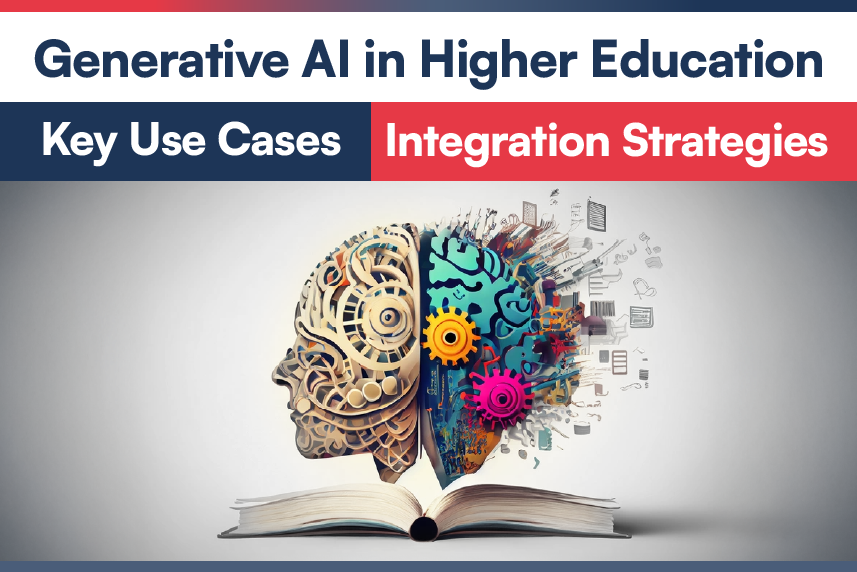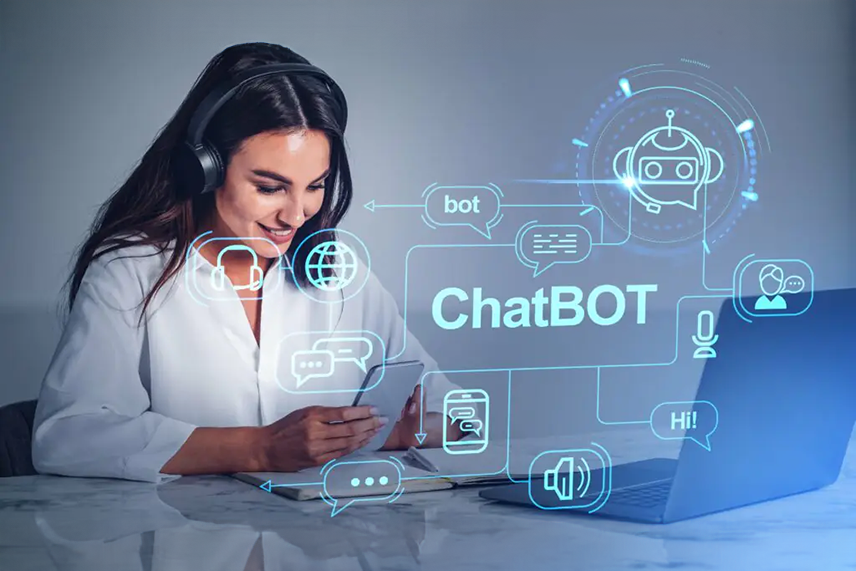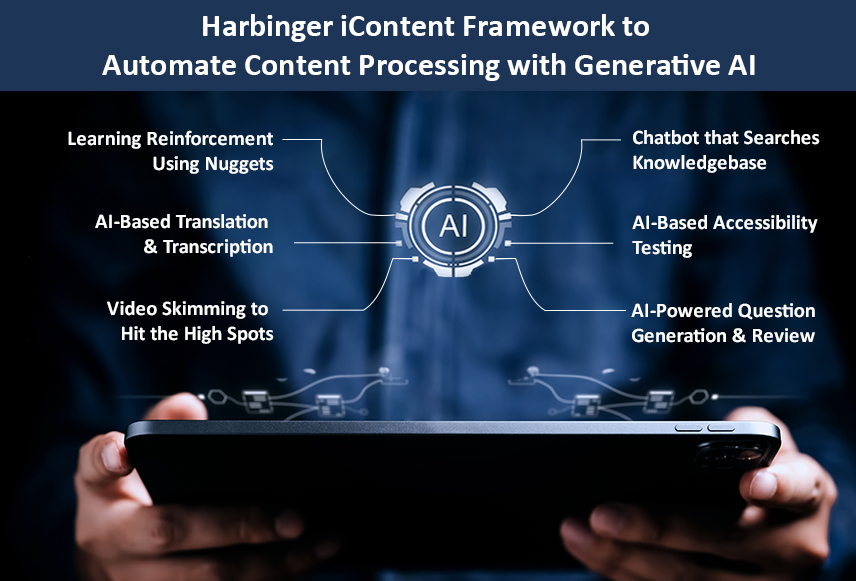
Did you know integrating Generative AI in higher education can revolutionize how we learn and teach? This transformative technology has the potential to automate learning content development and enhance the educational experience in ways previously unimaginable.
The applications of Generative AI in higher education are vast and game-changing. Consider an ML-powered virtual tutor that adapts teaching style to match the pace and comprehension of students. Imagine an NLP-based chatbot capable of autogenerating literature reviews, suggesting teaching methodologies, and automating learning reinforcement.
In this blog post, we will elucidate the incredible possibilities that Generative AI brings to higher education. We will also explore cutting-edge solutions to effectively integrate Generative AI and how educators and institutions can reap the benefits of this integration in the long run. Without further ado, let’s start.
Why Use Generative AI in Higher Education
Implementing Generative AI in higher education can offer various compelling advantages to educators and institutions. Here’s a compilation of a few of them to give you a better idea about the remarkable capabilities of this technological advancement.
1. Automate Administrative Tasks
Educators often find themselves burdened with administrative tasks that can limit their capabilities. Generative AI can automate such tasks, allowing educators to allocate more time and energy to teaching and mentoring.
For example, educators can use ChatGPT to quickly grade assignments, provide feedback, schedule classes, manage student records, resolve student queries, and provide additional learning resources on-demand.
According To Impact Research, 60% Of Teachers Have Used ChatGPT, Marking A 13-Point Surge Since February. The Survey Found That One-Third Of Teachers Use ChatGPT For Lesson Planning And Instructional Materials Creation. 30% Use It To Get Creative Ideas For Their Classes, While 30% Use It To Enhance Their Background Knowledge.
2. Boost Educator Productivity
Generative AI tools have the ability to develop and curate course materials. They can help educators develop customized learning resources, quizzes, and lesson plans more efficiently. This boosts productivity and enables educators to focus on refining their teaching methods and engaging with students.
3. Enhance Teaching Outcomes
Integrating Generative AI in higher education can help educators analyze individual student performance data and adapt course content accordingly. It can also help restructure teaching methodologies, optimize instructions, and identify loopholes in educational practices to improve teaching outcomes, like boosting student retention rates and fostering critical thinking skills.
4. Save Time and Cost
Generative AI can result in significant time and cost savings for institutions by automating administrative tasks and educational content creation. Educators can utilize the capabilities of Generative AI-driven analytics to identify areas where resources are underutilized or misallocated, enabling institutions to optimize their budgets and allocate resources more efficiently.

5. Improve Collaboration
Generative AI in education can facilitate collaboration among educators and researchers. Deploying Generative AI models in teaching and research environments can help identify potential collaborators based on research interests, suggest relevant literature, and simplify initiating collaborative projects.
This interdisciplinary collaboration and knowledge sharing will lead to innovative research outcomes and improved educational experiences.
6. Eliminate Bias
Generative AI can help mitigate bias in educational content and assessments. Generative AI-enabled grading systems can help educators effectively assess assignments, reducing the risk of subjective bias. Higher educational institutions can train and fine-tune Generative AI models to identify and remove biases in course materials, ensuring that education is inclusive and equitable.
Discover how technology can transform education and student engagement.
10 Use Cases of Generative AI in Higher Education
After knowing the benefits of implementing Generative AI in higher education, we can now move forward to understanding a few use cases where this innovative technology can create a lasting impact. How? Let’s understand in detail.
1. Curriculum Development
Generative AI can assist educators in designing and updating curricula. It can automate the creation of high-quality learning materials, such as textbooks, lecture notes, assignments, quizzes, MCQs, and test papers, tailored to specific courses and teaching objectives.
Utilizing the capabilities of AI in higher education can help educators create a variety of questions based on different difficulty levels, learning objectives, and topics. This can be a valuable resource for formative and summative assessments.

2. Chatbots for Student Support
Generative AI-enabled chatbots are valuable tools for educators seeking to enhance student support and engagement. These chatbots can help them provide immediate assistance to students, resolve queries, and offer guidance on course content. They can also prove beneficial in assigning homework, tracking progress, and facilitating discussions.
3. Personalized Learning
Higher educational institutions can use Generative AI to analyze students’ performance data and create personalized learning paths. For instance, they can automate skills gap analysis using AI models and transformers to provide student-centric courses and assignments.
Educators can utilize the insights gained from the analysis to tailor their teaching strategies, address individual student needs, and optimize the learning experience.
Learn how Harbinger helped an eminent leadership skilling platform deploy an AI-powered recommendation engine to deliver a personalized coaching experience.
4. Text Summarization
Harnessing the power of Generative AI in higher education can help educators effectively summarize text by condensing complex information into concise summaries. Through advanced NLP capabilities, Generative AI can analyze and understand the context of lengthy texts, identify key concepts, and summarize relevant details.
Imagine a professor wanting to summarize a dense, 50-page document for a lecture. Instead of spending hours manually distilling the information, the professor can use a Generative AI tool.
After inputting the required text, the Generative AI algorithms analyze the document and identify key events, figures, and themes to generate a concise and coherent summary that can be easily integrated into the lecture.
5. Translation and Transcription
Generative AI models can swiftly and accurately convert text from one language to another. They can generate alternative formats such as audio, braille, or a simplified language. These translation capabilities make it easier for educators to create multilingual learning materials or accommodate students with visual impairments, dyslexia, cognitive challenges, or diverse linguistic backgrounds.
On the other hand, educators can implement Generative AI to take full advantage of automated transcription and captioning. They can use pre-trained language models to initiate live transcription, closed captioning, and transcription in different formats.

6. Virtual Tutoring
Generative AI can simplify educational content delivery by facilitating virtual tutoring. Educators can leverage OpenAI models, advanced AI algorithms, and NLP to automate various aspects of virtual tutoring, such as creating personalized study materials, generating interactive assessments, and providing instant feedback to students.
7. Research Assistance
Employing Generative AI in higher education can significantly assist educators in their research endeavors. With trained ML models in place, educators can streamline literature review and data analysis. These models can swiftly sift through vast amounts of academic papers, books, and online resources to generate hypotheses and suggest potential research directions.
Generative AI can assist in creating research proposals, abstracts, and even initial drafts of scholarly articles. It can visualize data, generate graphs, and perform statistical analyses to make complex research tasks more accessible.
8. Virtual Labs and Simulations
Integrating Generative AI in higher education can help educators develop virtual labs and simulations with unprecedented ease and sophistication. It will help them automatically generate realistic 3D environments, interactive scenarios, and dynamic simulations that mimic real-world phenomena.
9. Professional Development
Generative AI can create personalized learning resources, curriculum materials, and instructional content tailored to the specific needs and preferences of educators. It can assist educational institutions in creating professional development roadmaps for educators.
Generative AI models can analyze and synthesize vast amounts of educational research and best practices. This can help educators refine teaching strategies, enhance pedagogical skills, and embrace continuous professional development.
10. Automated Assessment and Grading
Generative AI can help educational institutions automate certain aspects of grading, like evaluating objective questions, scoring assignments based on predefined criteria, and generating performance reports. It can analyze students’ responses to MCQs, quizzes, short tests, and essay-based assignments to help educators provide tailored yet qualitative feedback.
AI in assessments is potentially changing the way evaluations are done, making it faster, error-free, and personalized.
Integrate Generative AI in Higher Education with Harbinger
Harbinger is a global technology company that builds products and solutions that transform the way people work, learn, and teach. For more than three decades, we have been innovating alongside organizations that are in the people business—serving the Human Resources, eLearning, Digital Publishing, Education, and High-Tech sectors.
Our pedigree in building next-generation EdTech products has fostered a culture of continuous learning. We experiment with new technologies such as Generative AI, easily embrace new ideas, and creatively apply them to our customers’ products.
Harbinger is committed to exploring the limitless possibilities of AI in education to automate content development, redefine teaching, personalize learning, and improve educational outcomes.

Our intelligent content automation framework, ‘Harbinger iContent,’ powered by Generative AI technologies, can help educational institutions reinforce learning, autogenerate nuggets and questions, create video summaries, provide descriptive answers, translate and transcribe educational content, and personalize learning recommendations.
Our EdTech solutions are backed by Harbinger Content Automation (HCA) APIs that can help institutions unlock the true potential of Generative AI in education industry. HCA-APIs can positively impact higher education through their remarkable features and functionalities. How? Let’s take a look.
- Tagger – This API has the ability to automatically tag content with relevant keywords and categories, customize and create custom taxonomies, process and tag a wide range of file formats, perform deep text analysis, and easily integrate with content management systems and search engines.
- VideoSkimmer – With this API, higher educational institutions will be able to rapidly skim through videos, generate transcripts of video content, extract relevant keywords from video content, summarize video content with 95% accuracy, and process long videos (10-20 mins) asynchronously.
- Translator – It is a go-to API for educators who want to translate text from one language to another, automatically detect the source language, customize translations, translate various file formats, translate text in multiple languages, and process and translate text in real-time.
- Transcriber – This API can be the best bet to transcribe audio content into text, process various audio file formats, customize transcriptions, transcribe large amounts of audio content in one go, transcribe audio content in multiple languages, and generate timestamps for each spoken word or phrase.
- Summarizer – This API can help higher educational institutions generate concise summaries of text content, customize summaries by controlling length/type of information, summarize various text file formats, and process and summarize large amounts of text content.
- QuestionGenerator – This API has the ability to automatically generate multiple-choice, open-ended, and true/false questions, produce questions tailored to specific needs, process different types of data, and support various file formats.
- AccessibilityChecker – With this API, higher educational institutions can identify accessibility gaps without needing manual testing, meet WCAG accessibility standards, generate a Voluntary Product Accessibility Template (VPAT) for the content, and make educational content accessible.
Parting Thoughts
Integrating Generative AI in higher education offers various benefits for educators and educational institutions. It can transcend the conventional teaching boundaries, enriching the academic experience and transforming how knowledge is acquired and shared.
Using Generative AI in higher education can usher in a new era of knowledge-sharing and revolutionize pedagogical approaches. It can equip educators with the skills to adapt to modern teaching methodologies and design targeted educational content to improve learning outcomes.
If you want to implement Generative AI in higher education or seek dedicated assistance to create an AI-powered learning ecosystem for your educational institution, write to us at contact@harbingergroup.com. Our EdTech experts would be more than happy to help you meet your desired goals.






